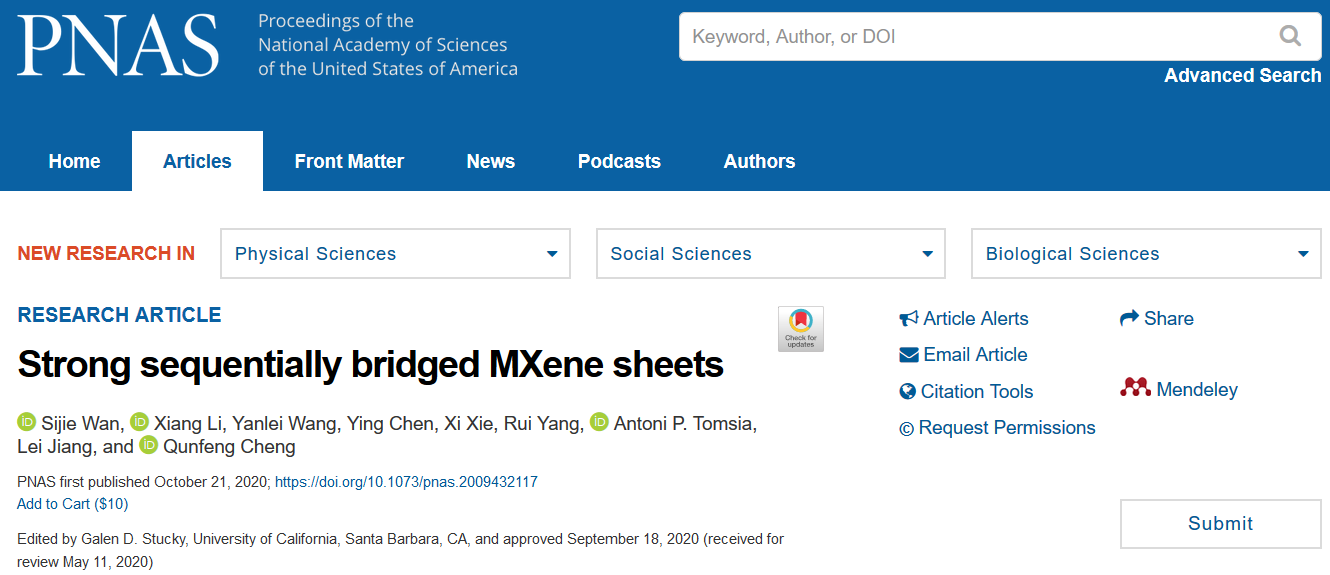A research team led by Prof. Cheng Qunfeng and Academician Jiang Lei from the School of Chemistry of Beihang University and their collaborators published their latest research titled "Strong sequentially bridged MXene sheets" in the Proceedings of the National Academy of Sciences of the United States of America (PNAS) on October 21, 2020. Wan Sijie, a postdoctoral fellow of Beihang “Zhuoyue” Program, and Li Xiang, an undergraduate student from the School of Chemistry, are the first authors. Prof. Cheng Qunfeng is the corresponding author.

Titanium carbide MXene, an emerging two-dimensional transition metal carbide with excellent mechanical properties and electrical conductivity, has great potential for use in aerospace and flexible electronics. However, the assembly of MXene nanosheets into macroscopic high-performance nanocomposites is challenging, limiting MXene's practical applications. In the paper, Prof. Cheng Qunfeng's research group proposed a bionic interface cross-linking strategy to construct high-performance MXene thin films.
The MXene thin film was constructed by sequentially introducing hydrogen bond (sodium alginate, SA) and ionic bond (Ca2+) into the MXene layer (Fig. 1), which formed a hydrogen bond between SA and MXene nanosheets. Ca2+ not only formed an ionic bond with MXene nanosheets, but also formed a chelate structure with SA molecules (similar to the interfacial crosslinking structure of mussel byssals). The interfacial interactions between MXene layers were greatly enhanced, so were the mechanical properties, electrical conductivity and electromagnetic shielding efficiency. It was found that the interfacial synergistic effect greatly improved the oxidation resistance of MXene films, which laid the foundation for the practical application of MXene films in the future. The results of molecular dynamics simulation further revealed the interfacial synergistic toughening mechanism of hydrogen bond and ionic bond, which provided the theoretical guidance for the preparation of other high-performance MXene nanocomposites.

Fig. 1. Fabrication and structural characterization of the hydrogen bonding-bridged MXene (HBM) sheet
Under the guidance of Academician Jiang Lei, this work was also contributed by the following collaborators: Dr. Wang Yanlei, Institute of Process Engineering, Chinese Academy of Sciences (CAS); Dr. Chen Ying, School of Stomatology, Peking University; Dr. Xie Xi and Researcher Yang Rui, Institute of Metal Research, CAS; and Prof. Antoni P. Tomsia, Lawrence Berkeley National Laboratory. Some simulations were supported by the Center for High Performance Computing of Beihang University.
This work was supported by the Excellent Young Scientist Foundation of National Natural Science Foundation of China, the National Natural Science Foundation of China, Newton Advanced Fellowship, Beijing Natural Science Foundation, the National Postdoctoral Program for Innovative Talents, the China Postdoctoral Science Foundation, etc.
More information of the article:
https://www.pnas.org/content/early/2020/10/20/2009432117
Webpage of Prof. Cheng Qunfeng’s research group:
Reported by Liu Naipeng
Reviewed by Liu Mingjie
Edited by Jia Aiping
Translated by Yin Ruyue

